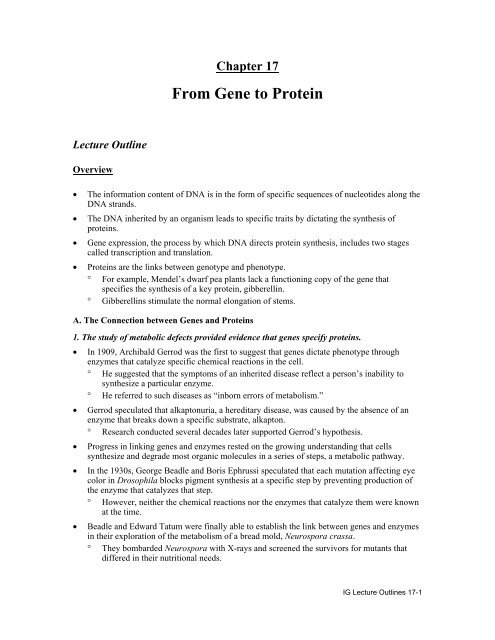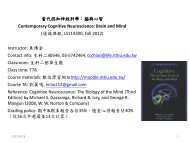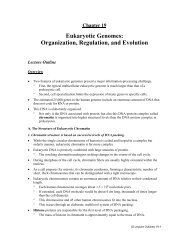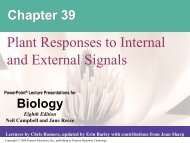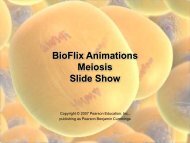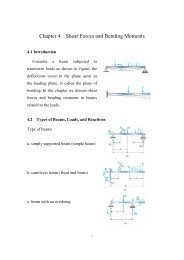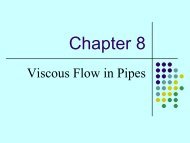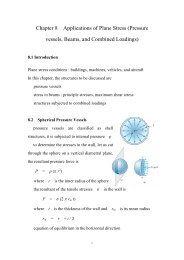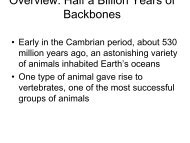CHAPTER 17 FROM GENE TO PROTEIN
CHAPTER 17 FROM GENE TO PROTEIN
CHAPTER 17 FROM GENE TO PROTEIN
- No tags were found...
Create successful ePaper yourself
Turn your PDF publications into a flip-book with our unique Google optimized e-Paper software.
Chapter <strong>17</strong>From Gene to ProteinLecture OutlineOverview• The information content of DNA is in the form of specific sequences of nucleotides along theDNA strands.• The DNA inherited by an organism leads to specific traits by dictating the synthesis ofproteins.• Gene expression, the process by which DNA directs protein synthesis, includes two stagescalled transcription and translation.• Proteins are the links between genotype and phenotype.° For example, Mendel’s dwarf pea plants lack a functioning copy of the gene thatspecifies the synthesis of a key protein, gibberellin.° Gibberellins stimulate the normal elongation of stems.A. The Connection between Genes and Proteins1. The study of metabolic defects provided evidence that genes specify proteins.• In 1909, Archibald Gerrod was the first to suggest that genes dictate phenotype throughenzymes that catalyze specific chemical reactions in the cell.° He suggested that the symptoms of an inherited disease reflect a person’s inability tosynthesize a particular enzyme.° He referred to such diseases as “inborn errors of metabolism.”• Gerrod speculated that alkaptonuria, a hereditary disease, was caused by the absence of anenzyme that breaks down a specific substrate, alkapton.° Research conducted several decades later supported Gerrod’s hypothesis.• Progress in linking genes and enzymes rested on the growing understanding that cellssynthesize and degrade most organic molecules in a series of steps, a metabolic pathway.• In the 1930s, George Beadle and Boris Ephrussi speculated that each mutation affecting eyecolor in Drosophila blocks pigment synthesis at a specific step by preventing production ofthe enzyme that catalyzes that step.° However, neither the chemical reactions nor the enzymes that catalyze them were knownat the time.• Beadle and Edward Tatum were finally able to establish the link between genes and enzymesin their exploration of the metabolism of a bread mold, Neurospora crassa.° They bombarded Neurospora with X-rays and screened the survivors for mutants thatdiffered in their nutritional needs.IG Lecture Outlines <strong>17</strong>-1
° Wild-type Neurospora can grow on a minimal medium of agar, inorganic salts, glucose,and the vitamin biotin.• Beadle and Tatum identified mutants that could not survive on minimal medium, becausethey were unable to synthesize certain essential molecules from the minimal ingredients.° However, most of these nutritional mutants can survive on a complete growth mediumthat includes all 20 amino acids and a few other nutrients.• One type of mutant required only the addition of arginine to the minimal growth medium.° Beadle and Tatum concluded that this mutant was defective somewhere in thebiochemical pathway that normally synthesizes arginine.° They identified three classes of arginine-deficient mutants, each apparently lacking a keyenzyme at a different step in the synthesis of arginine.° They demonstrated this by growing these mutant strains in media that provided differentintermediate molecules.° Their results provided strong evidence for the one gene–one enzyme hypothesis.• Later research refined the one gene–one enzyme hypothesis.• First, not all proteins are enzymes.° Keratin, the structural protein of hair, and insulin, a hormone, both are proteins and geneproducts.• This tweaked the hypothesis to one gene–one protein.• Later research demonstrated that many proteins are composed of several polypeptides, eachof which has its own gene.• Therefore, Beadle and Tatum’s idea has been restated as the one gene–one polypeptidehypothesis.• Some genes code for RNA molecules that play important roles in cells although they arenever translated into protein.2. Transcription and translation are the two main processes linking gene to protein.• Genes provide the instructions for making specific proteins.• The bridge between DNA and protein synthesis is the nucleic acid RNA.• RNA is chemically similar to DNA, except that it contains ribose as its sugar and substitutesthe nitrogenous base uracil for thymine.° An RNA molecule almost always consists of a single strand.• In DNA or RNA, the four nucleotide monomers act like the letters of the alphabet tocommunicate information.• The specific sequence of hundreds or thousands of nucleotides in each gene carries theinformation for the primary structure of proteins, the linear order of the 20 possible aminoacids.• To get from DNA, written in one chemical language, to protein, written in another, requirestwo major stages: transcription and translation.• During transcription, a DNA strand provides a template for the synthesis of acomplementary RNA strand.IG Lecture Outlines <strong>17</strong>-2
° Just as a DNA strand provides a template for the synthesis of each new complementarystrand during DNA replication, it provides a template for assembling a sequence of RNAnucleotides.• Transcription of many genes produces a messenger RNA (mRNA) molecule.• During translation, there is a change of language.° The site of translation is the ribosome, complex particles that facilitate the orderlyassembly of amino acids into polypeptide chains.• Why can’t proteins be translated directly from DNA?° The use of an RNA intermediate provides protection for DNA and its genetic information.° Using an RNA intermediate allows more copies of a protein to be made simultaneously,since many RNA transcripts can be made from one gene.• Also, each gene transcript can be translated repeatedly.• The basic mechanics of transcription and translation are similar in eukaryotes andprokaryotes.• Because bacteria lack nuclei, their DNA is not segregated from ribosomes and other proteinsynthesizingequipment.° This allows the coupling of transcription and translation.° Ribosomes attach to the leading end of an mRNA molecule while transcription is still inprogress.• In a eukaryotic cell, transcription occurs in the nucleus, and translation occurs at ribosomes inthe cytoplasm.° The transcription of a protein-coding eukaryotic gene results in pre-mRNA.° The initial RNA transcript of any gene is called a primary transcript.° RNA processing yields the finished mRNA.• To summarize, genes program protein synthesis via genetic messages in the form ofmessenger RNA.• The molecular chain of command in a cell is DNA RNA protein.3. In the genetic code, nucleotide triplets specify amino acids.• If the genetic code consisted of a single nucleotide or even pairs of nucleotides per aminoacid, there would not be enough combinations (4 and 16, respectively) to code for all 20amino acids.• Triplets of nucleotide bases are the smallest units of uniform length that can code for all theamino acids.• With a triplet code, three consecutive bases specify an amino acid, creating 4 3 (64) possiblecode words.• The genetic instructions for a polypeptide chain are written in DNA as a series ofnonoverlapping three-nucleotide words.• During transcription, one DNA strand, the template strand, provides a template for orderingthe sequence of nucleotides in an RNA transcript.° A given DNA strand can be the template strand for some genes along a DNA molecule,while for other genes in other regions, the complementary strand may function as thetemplate.IG Lecture Outlines <strong>17</strong>-3
• The complementary RNA molecule is synthesized according to base-pairing rules, except thaturacil is the complementary base to adenine.• Like a new strand of DNA, the RNA molecule is synthesized in an antiparallel direction tothe template strand of DNA.• The mRNA base triplets are called codons, and they are written in the 5’ 3’ direction.• During translation, the sequence of codons along an mRNA molecule is translated into asequence of amino acids making up the polypeptide chain.° During translation, the codons are read in the 5’ 3’ direction along the mRNA.° Each codon specifies which one of the 20 amino acids will be incorporated at thecorresponding position along a polypeptide.• Because codons are base triplets, the number of nucleotides making up a genetic messagemust be three times the number of amino acids making up the protein product.° It takes at least 300 nucleotides to code for a polypeptide that is 100 amino acids long.• The task of matching each codon to its amino acid counterpart began in the early 1960s.• Marshall Nirenberg determined the first match: UUU coded for the amino acid phenylalanine.° He created an artificial mRNA molecule entirely of uracil and added it to a test tubemixture of amino acids, ribosomes, and other components for protein synthesis.° This “poly-U” translated into a polypeptide containing a single amino acid, phenylalanine,in a long chain.• AAA, GGG, and CCC were solved in the same way.• Other more elaborate techniques were required to decode mixed triplets such as AUA andCGA.• By the mid-1960s the entire code was deciphered.° Sixty-one of 64 triplets code for amino acids.° The codon AUG not only codes for the amino acid methionine, but also indicates the“start” of translation.° Three codons do not indicate amino acids but are “stop” signals marking the terminationof translation.• There is redundancy in the genetic code but no ambiguity.° Several codons may specify the same amino acid, but no codon specifies more than oneamino acid.° The redundancy in the code is not random. In many cases, codons that are synonyms for aparticular amino acid differ only in the third base of the triplet.• To extract the message from the genetic code requires specifying the correct starting point.° This establishes the reading frame; subsequent codons are read in groups of threenucleotides.° The cell’s protein-synthesizing machinery reads the message as a series ofnonoverlapping three-letter words.• In summary, genetic information is encoded as a sequence of nonoverlapping base triplets, orcodons, each of which is translated into a specific amino acid during protein synthesis.4. The genetic code must have evolved very early in the history of life.IG Lecture Outlines <strong>17</strong>-4
• The genetic code is nearly universal, shared by organisms from the simplest bacteria to themost complex plants and animals.• In laboratory experiments, genes can be transcribed and translated after they are transplantedfrom one species to another.° This has permitted bacteria to be programmed to synthesize certain human proteins afterinsertion of the appropriate human genes.• Such applications are exciting developments in biotechnology.• Exceptions to the universality of the genetic code exist in certain unicellular eukaryotes andin the organelle genes of some species.° Some prokaryotes can translate stop codons into one of two amino acids not found inmost organisms.• The evolutionary significance of the near universality of the genetic code is clear.° A language shared by all living things arose very early in the history of life—earlyenough to be present in the common ancestors of all modern organisms.• A shared genetic vocabulary is a reminder of the kinship that bonds all life on Earth.B. The Synthesis and Processing of RNA1. Transcription is the DNA-directed synthesis of RNA: a closer look.• Messenger RNA, the carrier of information from DNA to the cell’s protein-synthesizingmachinery, is transcribed from the template strand of a gene.• RNA polymerase separates the DNA strands at the appropriate point and bonds the RNAnucleotides as they base-pair along the DNA template.° Like DNA polymerases, RNA polymerases can only assemble a polynucleotide in its 5’ 3’ direction.° Unlike DNA polymerases, RNA polymerases are able to start a chain from scratch; theydon’t need a primer.• Specific sequences of nucleotides along the DNA mark where gene transcription begins andends.° RNA polymerase attaches and initiates transcription at the promoter.° In prokaryotes, the sequence that signals the end of transcription is called the terminator.• Molecular biologists refer to the direction of transcription as “downstream” and the otherdirection as “upstream.”• The stretch of DNA that is transcribed into an RNA molecule is called a transcription unit.• Bacteria have a single type of RNA polymerase that synthesizes all RNA molecules.• In contrast, eukaryotes have three RNA polymerases (I, II, and III) in their nuclei.° RNA polymerase II is used for mRNA synthesis.• Transcription can be separated into three stages: initiation, elongation, and termination of theRNA chain.• The presence of a promoter sequence determines which strand of the DNA helix is thetemplate.° Within the promoter is the starting point for the transcription of a gene.IG Lecture Outlines <strong>17</strong>-5
° The promoter also includes a binding site for RNA polymerase several dozen nucleotides“upstream” of the start point.• In prokaryotes, RNA polymerase can recognize and bind directly to the promoter region.• In eukaryotes, proteins called transcription factors mediate the binding of RNA polymeraseand the initiation of transcription.• Only after certain transcription factors are attached to the promoter does RNA polymerase IIbind to it.• The completed assembly of transcription factors and RNA polymerase II bound to a promoteris called a transcription initiation complex.° A crucial promoter DNA sequence is called a TATA box.• RNA polymerase then starts transcription.• As RNA polymerase moves along the DNA, it untwists the double helix, 10 to 20 bases attime.° The enzyme adds nucleotides to the 3’ end of the growing strand.• Behind the point of RNA synthesis, the double helix re-forms and the RNA molecule peelsaway.° Transcription progresses at a rate of 60 nucleotides per second in eukaryotes.• A single gene can be transcribed simultaneously by several RNA polymerases at a time.• A growing strand of RNA trails off from each polymerase.° The length of each new strand reflects how far along the template the enzyme hastraveled from the start point.• The congregation of many polymerase molecules simultaneously transcribing a single geneincreases the amount of mRNA transcribed from it.• This helps the cell make the encoded protein in large amounts.• Transcription proceeds until after the RNA polymerase transcribes a terminator sequence inthe DNA.° In prokaryotes, RNA polymerase stops transcription right at the end of the terminator.• Both the RNA and DNA are then released.° In eukaryotes, the pre-mRNA is cleaved from the growing RNA chain while RNApolymerase II continues to transcribe the DNA.• Specifically, the polymerase transcribes a DNA sequence called the polyadenylationsignal sequence that codes for a polyadenylation sequence (AAUAAA) in the premRNA.• At a point about 10 to 35 nucleotides past this sequence, the pre-mRNA is cut fromthe enzyme.• The polymerase continues transcribing for hundreds of nucleotides.• Transcription is terminated when the polymerase eventually falls off the DNA.2. Eukaryotic cells modify RNA after transcription.• Enzymes in the eukaryotic nucleus modify pre-mRNA before the genetic messages aredispatched to the cytoplasm.° During RNA processing, both ends of the primary transcript are usually altered.° Certain interior parts of the molecule are cut out and the remaining parts spliced together.IG Lecture Outlines <strong>17</strong>-6
• At the 5’ end of the pre-mRNA molecule, a modified form of guanine is added, the 5’ cap.• At the 3’ end, an enzyme adds 50 to 250 adenine nucleotides, the poly-A tail.• These modifications share several important functions.° They seem to facilitate the export of mRNA from the nucleus.° They help protect mRNA from hydrolytic enzymes.° They help the ribosomes attach to the 5’ end of the mRNA.• The most remarkable stage of RNA processing occurs during the removal of a large portionof the RNA molecule in a cut-and-paste job of RNA splicing.• Most eukaryotic genes and their RNA transcripts have long noncoding stretches ofnucleotides.° Noncoding segments of nucleotides called intervening regions, or introns, lie betweencoding regions.° The final mRNA transcript includes coding regions, exons, which are translated intoamino acid sequences, plus the leader and trailer sequences.• RNA splicing removes introns and joins exons to create an mRNA molecule with acontinuous coding sequence.• This splicing is accomplished by a spliceosome.° Spliceosomes consist of a variety of proteins and several small nuclearribonucleoproteins (snRNPs) that recognize the splice sites.° snRNPs are located in the cell nucleus and are composed of RNA and protein molecules.° Each snRNP has several protein molecules and a small nuclear RNA molecule (snRNA).• Each snRNA is about 150 nucleotides long.• The spliceosome interacts with certain sites along an intron, releasing the introns and joiningtogether the two exons that flanked the introns.° snRNAs appear to play a major role in catalytic processes, as well as spliceosomeassembly and splice site recognition.• The idea of a catalytic role for snRNA arose from the discovery of ribozymes, RNAmolecules that function as enzymes.° In some organisms, splicing occurs without proteins or additional RNA molecules.° The intron RNA functions as a ribozyme and catalyzes its own excision.° For example, in the protozoan Tetrahymena, self-splicing occurs in the production ofribosomal RNA (rRNA), a component of the organism’s ribosomes.° The pre-rRNA actually removes its own introns.• The discovery of ribozymes rendered obsolete the statement, “All biological catalysts areproteins.”• The fact that RNA is single-stranded plays an important role in allowing certain RNAmolecules to function as ribozymes.• A region of the RNA molecule may base-pair with a complementary region elsewhere in thesame molecule, thus giving the RNA a specific 3-D structure that is key to its ability tocatalyze reactions.• Introns and RNA splicing appear to have several functions.IG Lecture Outlines <strong>17</strong>-7
° Some introns play a regulatory role in the cell. These introns contain sequences thatcontrol gene activity in some way.° Splicing itself may regulate the passage of mRNA from the nucleus to the cytoplasm.° One clear benefit of split genes is to enable one gene to encode for more than onepolypeptide.• Alternative RNA splicing gives rise to two or more different polypeptides, depending onwhich segments are treated as exons.° Sex differences in fruit flies may be due to differences in splicing RNA transcribed fromcertain genes.° Early results of the Human Genome Project indicate that this phenomenon may becommon in humans, and may explain why we have a relatively small number of genes.• Proteins often have a modular architecture with discrete structural and functional regionscalled domains.• The presence of introns in a gene may facilitate the evolution of new and potentially usefulproteins as a result of a process known as exon shuffling.° In many cases, different exons code for different domains of a protein.• The presence of introns increases the probability of potentially beneficial crossing overbetween genes.° Introns increase the opportunity for recombination between two alleles of a gene.• This raises the probability that a crossover will switch one version of an exon foranother version found on the homologous chromosome.° There may also be occasional mixing and matching of exons between completelydifferent genes.° Either way, exon shuffling can lead to new proteins through novel combinations offunctions.C. The Synthesis of Protein1. Translation is the RNA-directed synthesis of a polypeptide: a closer look.• In the process of translation, a cell interprets a series of codons along an mRNA molecule andbuilds a polypeptide.• The interpreter is transfer RNA (tRNA), which transfers amino acids from the cytoplasmicpool to a ribosome.° A cell has all 20 amino acids available in its cytoplasm, either by synthesizing them fromscratch or by taking them up from the surrounding solution.• The ribosome adds each amino acid carried by tRNA to the growing end of the polypeptidechain.• During translation, each type of tRNA links an mRNA codon with the appropriate amino acid.• Each tRNA arriving at the ribosome carries a specific amino acid at one end and has aspecific nucleotide triplet, an anticodon, at the other.• The anticodon base-pairs with a complementary codon on mRNA.° If the codon on mRNA is UUU, a tRNA with an AAA anticodon and carryingphenylalanine will bind to it.IG Lecture Outlines <strong>17</strong>-8
• Codon by codon, tRNAs deposit amino acids in the prescribed order, and the ribosome joinsthem into a polypeptide chain.• The tRNA molecule is a translator, because it can read a nucleic acid word (the mRNA codon)and translate it to a protein word (the amino acid).• Like other types of RNA, tRNA molecules are transcribed from DNA templates in thenucleus.• Once it reaches the cytoplasm, each tRNA is used repeatedly, picking up its designated aminoacid in the cytosol, depositing the amino acid at the ribosome, and returning to the cytosol topick up another copy of that amino acid.• A tRNA molecule consists of a strand of about 80 nucleotides that folds back on itself to forma three-dimensional structure.° It includes a loop containing the anticodon and an attachment site at the 3’ end for anamino acid.• If each anticodon had to be a perfect match to each codon, we would expect to find 61 typesof tRNA, but the actual number is about 45.• The anticodons of some tRNAs recognize more than one codon.• This is possible because the rules for base pairing between the third base of the codon andanticodon are relaxed (called wobble).° At the wobble position, U on the anticodon can bind with A or G in the third position of acodon.° Wobble explains why the synonymous codons for a given amino acid can differ in theirthird base, but not usually in their other bases.• Each amino acid is joined to the correct tRNA by aminoacyl-tRNA synthetase.• The 20 different synthetases match the 20 different amino acids.° Each has active sites for only a specific tRNA-and-amino-acid combination.° The synthetase catalyzes a covalent bond between them in a process driven by ATPhydrolysis.• The result is an aminoacyl-tRNA or activated amino acid.• Ribosomes facilitate the specific coupling of the tRNA anticodons with mRNA codonsduring protein synthesis.° Each ribosome is made up of a large and a small subunit.° The subunits are composed of proteins and ribosomal RNA (rRNA), the most abundantRNA in the cell.• In eukaryotes, the subunits are made in the nucleolus.° After rRNA genes are transcribed to rRNA in the nucleus, the rRNA and proteins areassembled to form the subunits with proteins from the cytoplasm.• The subunits exit the nucleus via nuclear pores.• The large and small subunits join to form a functional ribosome only when they attach to anmRNA molecule.• While very similar in structure and function, prokaryotic and eukaryotic ribosomes haveenough differences that certain antibiotic drugs (like tetracycline) can paralyze prokaryoticribosomes without inhibiting eukaryotic ribosomes.IG Lecture Outlines <strong>17</strong>-9
• Each ribosome has a binding site for mRNA and three binding sites for tRNA molecules.° The P site holds the tRNA carrying the growing polypeptide chain.° The A site carries the tRNA with the next amino acid to be added to the chain.° Discharged tRNAs leave the ribosome at the E (exit) site.• The ribosome holds the tRNA and mRNA in close proximity and positions the new aminoacid for addition to the carboxyl end of the growing polypeptide.° It then catalyzes the formation of the peptide bond.° As the polypeptide becomes longer, it passes through an exit tunnel in the ribosome’slarge unit and is released to the cytosol.• Recent advances in our understanding of the structure of the ribosome strongly support thehypothesis that rRNA, not protein, carries out the ribosome’s functions.° RNA is the main constituent at the interphase between the two subunits and of the A andP sites.° It is the catalyst for peptide bond formation.° A ribosome can be regarded as one colossal ribozyme.• Translation can be divided into three stages: initiation, elongation, and termination.• All three phases require protein “factors” that aid in the translation process.• Both initiation and chain elongation require energy provided by the hydrolysis of GTP.• Initiation brings together mRNA, a tRNA with the first amino acid, and the two ribosomalsubunits.° First, a small ribosomal subunit binds with mRNA and a special initiator tRNA, whichcarries methionine and attaches to the start codon.° The small subunit then moves downstream along the mRNA until it reaches the startcodon, AUG, which signals the start of translation.• This establishes the reading frame for the mRNA.• The initiator tRNA, already associated with the complex, then hydrogen-bonds withthe start codon.° Proteins called initiation factors bring in the large subunit so that the initiator tRNAoccupies the P site.• Elongation involves the participation of several protein elongation factors, and consists of aseries of three-step cycles as each amino acid is added to the proceeding one.° During codon recognition, an elongation factor assists hydrogen bonding between themRNA codon under the A site with the corresponding anticodon of tRNA carrying theappropriate amino acid.• This step requires the hydrolysis of two GTP.° During peptide bond formation, an rRNA molecule catalyzes the formation of a peptidebond between the polypeptide in the P site with the new amino acid in the A site.• This step separates the tRNA at the P site from the growing polypeptide chain andtransfers the chain, now one amino acid longer, to the tRNA at the A site.° During translocation, the ribosome moves the tRNA with the attached polypeptide fromthe A site to the P site.• Because the anticodon remains bonded to the mRNA codon, the mRNA moves alongwith it.• The next codon is now available at the A site.IG Lecture Outlines <strong>17</strong>-10
• The tRNA that had been in the P site is moved to the E site and then leaves theribosome.• Translocation is fueled by the hydrolysis of GTP.• Effectively, translocation ensures that the mRNA is “read” 5’ 3’ codon by codon.° • The three steps of elongation continue to add amino acids codon by codon untilthe polypeptide chain is completed.• Termination occurs when one of the three stop codons reaches the A site.° A release factor binds to the stop codon and hydrolyzes the bond between thepolypeptide and its tRNA in the P site.° This frees the polypeptide, and the translation complex disassembles.• Typically a single mRNA is used to make many copies of a polypeptide simultaneously.° Multiple ribosomes, polyribosomes, may trail along the same mRNA.° Polyribosomes can be found in prokaryotic and eukaryotic cells.• A ribosome requires less than a minute to translate an average-sized mRNA into apolypeptide.• During and after synthesis, a polypeptide coils and folds to its three-dimensional shapespontaneously.° The primary structure, the order of amino acids, determines the secondary and tertiarystructure.• Chaperone proteins may aid correct folding.• In addition, proteins may require posttranslational modifications before doing their particularjob.° This may require additions such as sugars, lipids, or phosphate groups to amino acids.° Enzymes may remove some amino acids or cleave whole polypeptide chains.° Two or more polypeptides may join to form a protein.2. Signal peptides target some eukaryotic polypeptides to specific destinations in the cell.• Two populations of ribosomes, free and bound, are active participants in protein synthesis.• Free ribosomes are suspended in the cytosol and synthesize proteins that reside in the cytosol.• Bound ribosomes are attached to the cytosolic side of the endoplasmic reticulum.° They synthesize proteins of the endomembrane system as well as proteins secreted fromthe cell.• While bound and free ribosomes are identical in structure, their location depends on the typeof protein that they are synthesizing.• Translation in all ribosomes begins in the cytosol, but a polypeptide destined for theendomembrane system or for export has a specific signal peptide region at or near theleading end.° This consists of a sequence of about 20 amino acids.• A signal recognition particle (SRP) binds to the signal peptide and attaches it and itsribosome to a receptor protein in the ER membrane.° The SRP consists of a protein-RNA complex.IG Lecture Outlines <strong>17</strong>-11
• After binding, the SRP leaves and protein synthesis resumes with the growing polypeptidesnaking across the membrane into the cisternal space via a protein pore.° An enzyme usually cleaves the signal polypeptide.• Secretory proteins are released entirely into the cisternal space, but membrane proteinsremain partially embedded in the ER membrane.• Other kinds of signal peptides are used to target polypeptides to mitochondria, chloroplasts,the nucleus, and other organelles that are not part of the endomembrane system.° In these cases, translation is completed in the cytosol before the polypeptide is importedinto the organelle.° While the mechanisms of translocation vary, each of these polypeptides has a “ZIP code”that ensures its delivery to the correct cellular location.• Prokaryotes also employ signal sequences to target proteins for secretion.3. RNA plays multiple roles in the cell: a review.• The cellular machinery of protein synthesis and ER targeting is dominated by various kindsof RNA.° In addition to mRNA, these include tRNA; rRNA; and in eukaryotes, snRNA and SRPRNA.° A type of RNA called small nucleolar RNA (snoRNA) aids in processing pre-rRNAtranscripts in the nucleolus, a process necessary for ribosome formation.° Recent research has also revealed the presence of small, single-stranded and doublestrandedRNA molecules that play important roles in regulating which genes getexpressed.• These types of RNA include small interfering RNA (siRNA) and microRNA(miRNA).° The diverse functions of RNA are based, in part, on its ability to form hydrogen bondswith other nucleic acid molecules (DNA or RNA).° It can also assume a specific three-dimensional shape by forming hydrogen bondsbetween bases in different parts of its polynucleotide chain.• DNA may be the genetic material of all living cells today, but RNA is much more versatile.• The diverse functions of RNA range from structural to informational to catalytic.4. Comparing protein synthesis in prokaryotes and eukaryotes reveals key differences.• Although prokaryotes and eukaryotes carry out transcription and translation in very similarways, they do have differences in cellular machinery and in details of the processes.° Eukaryotic RNA polymerases differ from those of prokaryotes and require transcriptionfactors.° They differ in how transcription is terminated.° Their ribosomes also are different.• One major difference is that prokaryotes can transcribe and translate the same genesimultaneously.° The new protein quickly diffuses to its operating site.• In eukaryotes, the nuclear envelope segregates transcription from translation.° In addition, extensive RNA processing is carried out between these processes.IG Lecture Outlines <strong>17</strong>-12
° This provides additional steps whose regulation helps coordinate the elaborate activitiesof a eukaryotic cell.• Eukaryotic cells also have complicated mechanisms for targeting proteins to the appropriateorganelle.5. Point mutations can affect protein structure and function.• Mutations are changes in the genetic material of a cell (or virus).• These include large-scale mutations in which long segments of DNA are affected (forexample, translocations, duplications, and inversions).• A chemical change in just one base pair of a gene causes a point mutation.• If these occur in gametes or cells producing gametes, they may be transmitted to futuregenerations.• For example, sickle-cell disease is caused by a mutation of a single base pair in the gene thatcodes for one of the polypeptides of hemoglobin.° A change in a single nucleotide from T to A in the DNA template leads to an abnormalprotein.• A point mutation that results in the replacement of a pair of complementary nucleotides withanother nucleotide pair is called a base-pair substitution.• Some base-pair substitutions have little or no impact on protein function.° In silent mutations, altered nucleotides still code for the same amino acids because ofredundancy in the genetic code.° Other changes lead to switches from one amino acid to another with similar properties.° Still other mutations may occur in a region where the exact amino acid sequence is notessential for function.• Other base-pair substitutions cause a readily detectable change in a protein.° These are usually detrimental but can occasionally lead to an improved protein or onewith novel capabilities.° Changes in amino acids at crucial sites, especially active sites, are likely to impactfunction.• Missense mutations are those that still code for an amino acid but a different one.• Nonsense mutations change an amino acid codon into a stop codon, nearly always leading toa nonfunctional protein.• Insertions and deletions are additions or losses of nucleotide pairs in a gene.° These have a disastrous effect on the resulting protein more often than substitutions do.• Unless insertion or deletion mutations occur in multiples of three, they cause a frameshiftmutation.° All the nucleotides downstream of the deletion or insertion will be improperly groupedinto codons.° The result will be extensive missense, ending sooner or later in nonsense—prematuretermination.• Mutations can occur in a number of ways.° Errors can occur during DNA replication, DNA repair, or DNA recombination.IG Lecture Outlines <strong>17</strong>-13
° These can lead to base-pair substitutions, insertions, or deletions, as well as mutationsaffecting longer stretches of DNA.° These are called spontaneous mutations.• Rough estimates suggest that about 1 nucleotide in every 10 10 is altered and inherited bydaughter cells.• Mutagens are chemical or physical agents that interact with DNA to cause mutations.• Physical agents include high-energy radiation like X-rays and ultraviolet light.• Chemical mutagens fall into several categories.° Some chemicals are base analogues that may be substituted into DNA, but they pairincorrectly during DNA replication.° Other mutagens interfere with DNA replication by inserting into DNA and distorting thedouble helix.° Still others cause chemical changes in bases that change their pairing properties.• Researchers have developed various methods to test the mutagenic activity of differentchemicals.° These tests are often used as a preliminary screen of chemicals to identify those that maycause cancer.° This makes sense because most carcinogens are mutagenic and most mutagens arecarcinogenic.6. What is a gene? We revisit the question.• The Mendelian concept of a gene views it as a discrete unit of inheritance that affectsphenotype.° Morgan and his colleagues assigned genes to specific loci on chromosomes.° We can also view a gene as a specific nucleotide sequence along a region of a DNAmolecule.• We can define a gene functionally as a DNA sequence that codes for a specificpolypeptide chain.• All these definitions are useful in certain contexts.• Even the one gene–one polypeptide definition must be refined and applied selectively.° Most eukaryotic genes contain large introns that have no corresponding segments inpolypeptides.° Promoters and other regulatory regions of DNA are not transcribed either, but they mustbe present for transcription to occur.° Our molecular definition must also include the various types of RNA that are nottranslated into polypeptides, such as rRNA, tRNA, and other RNAs.• This is our definition of a gene: A gene is a region of DNA whose final product is either apolypeptide or an RNA molecule.IG Lecture Outlines <strong>17</strong>-14


